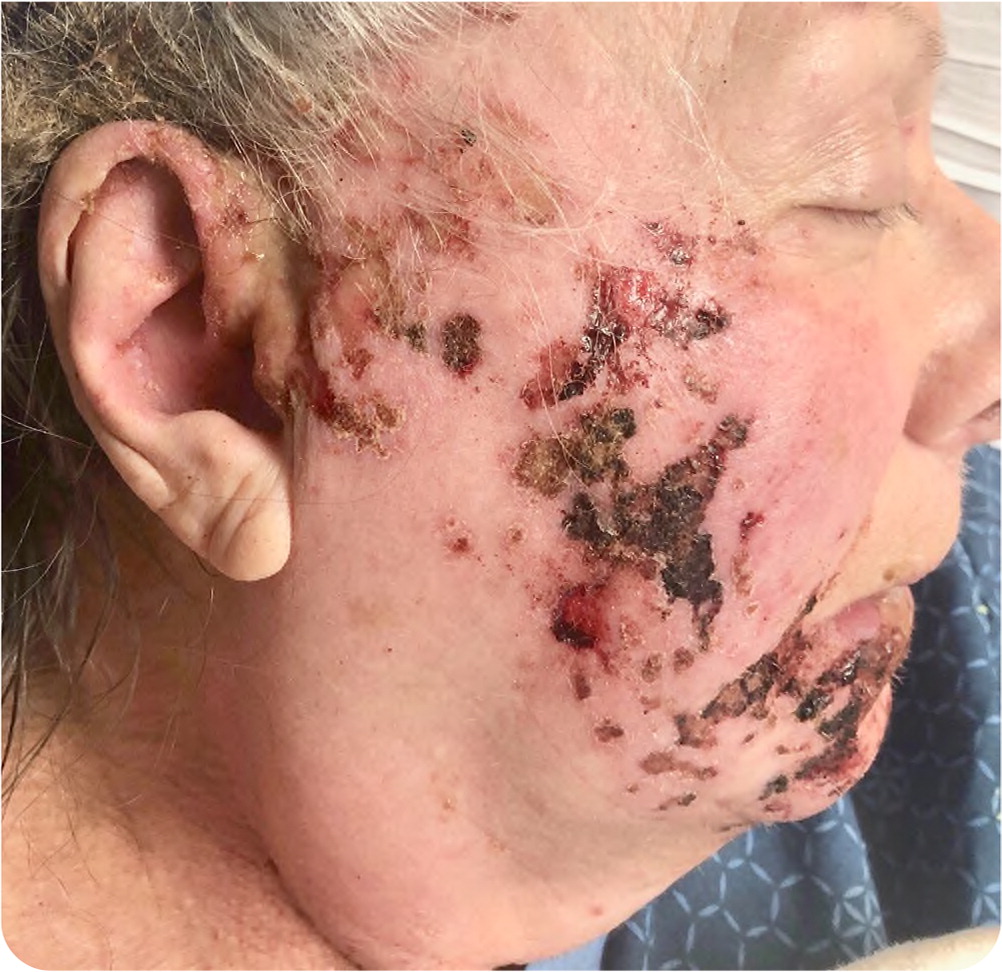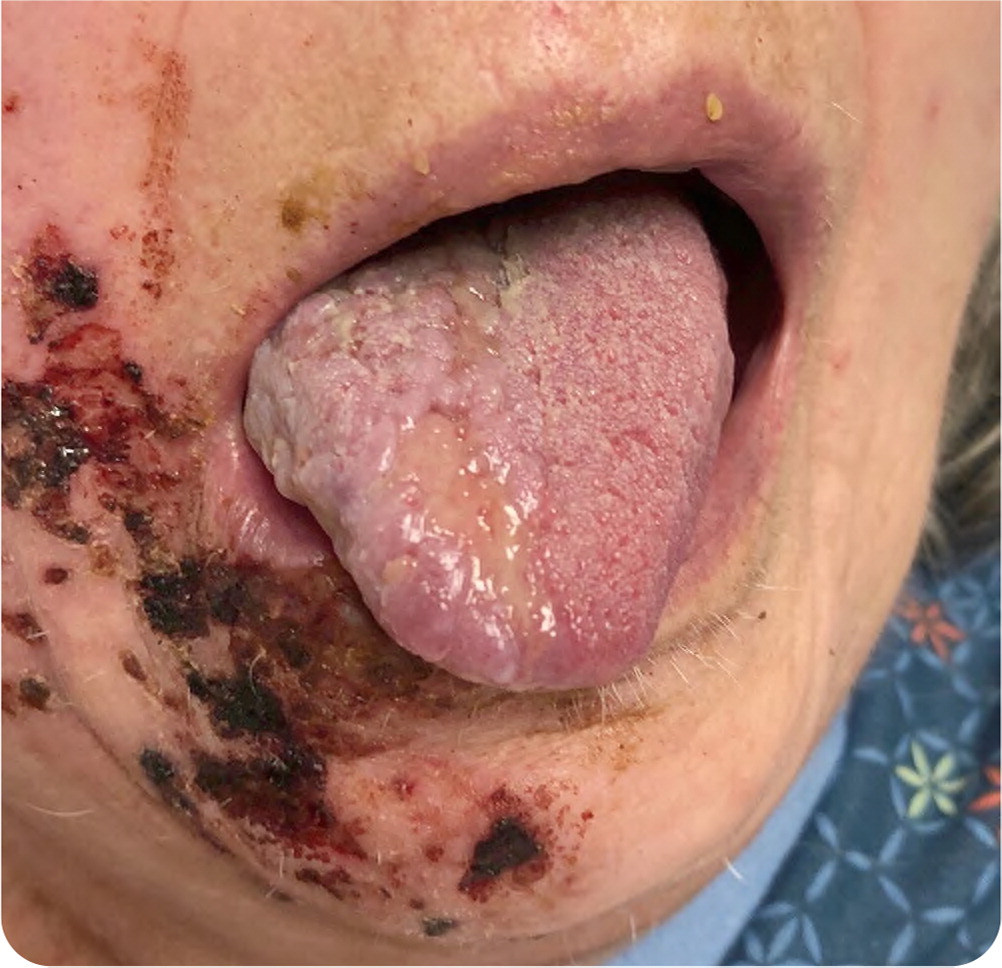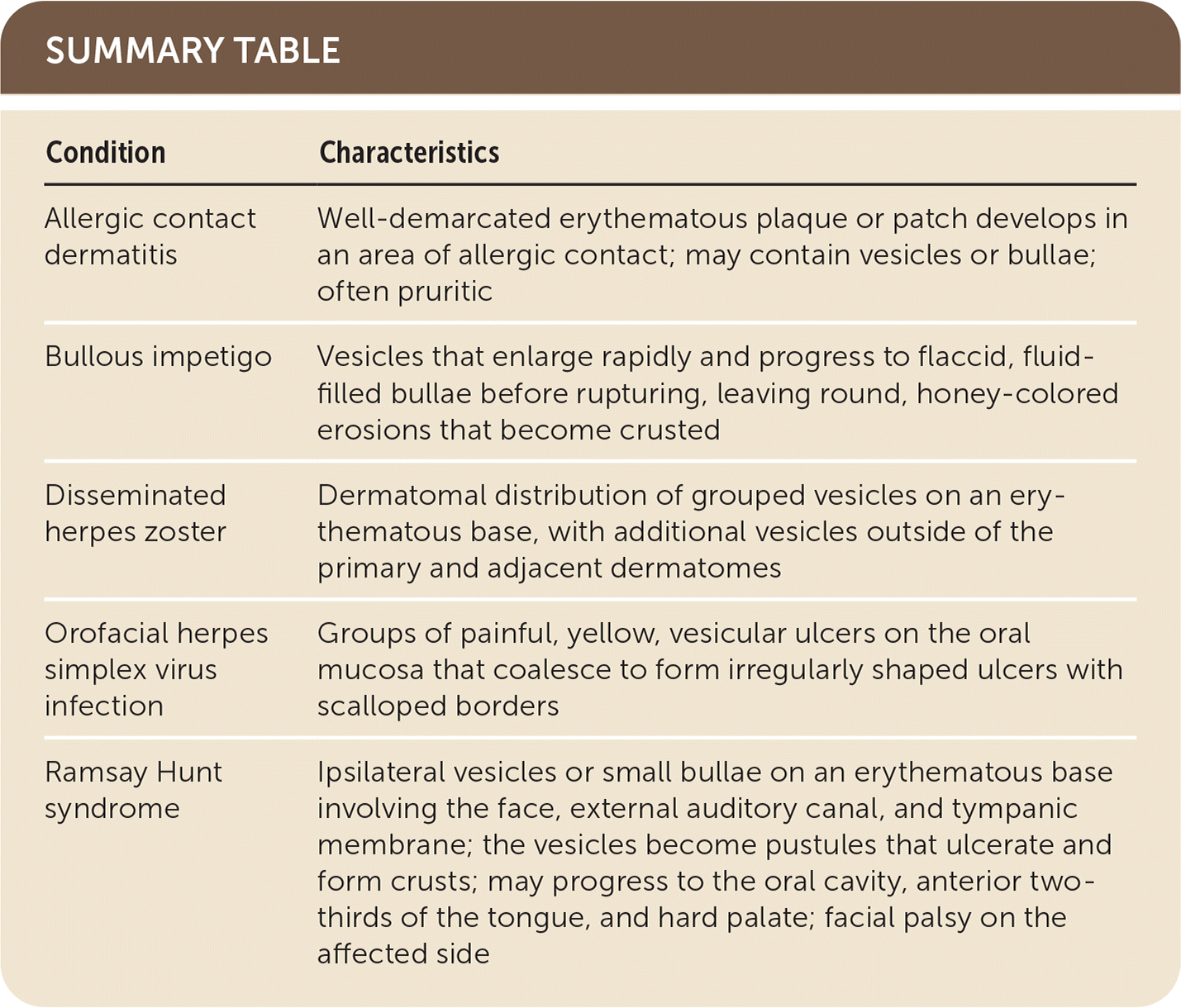
Am Fam Physician. 2020;102(4):243-244
Author disclosure: No relevant financial affiliations.
An 82-year-old patient presented with a worsening facial rash that appeared one week earlier. The rash initially presented as vesicles on the right side of the face accompanied by intermittent pruritus and facial dysesthesia. Ten days before the rash developed, the patient was treated with azithromycin (Zithromax) and nystatin for pharyngitis and thrush but discontinued these medications when the rash began. The medical history was significant for hypertension, atrial fibrillation, and coronary artery disease. The patient reported subjective fevers, odynophagia, and otalgia.
Physical examination revealed extensive eroded ulcerations with significant serosanguineous crusting on the right external ear, lower face, and jaw (Figure 1) and lesions on the right buccal mucosa and on half of the tongue (Figure 2). There were no vesicles or bullae. The patient also had right-sided facial droop. Superficial wound culture demonstrated mixed gram-positive cocci likely representative of skin flora.


Question
Discussion
The answer is E: Ramsay Hunt syndrome. Ramsay Hunt syndrome is an infectious disease process caused by reactivation of latent varicella-zoster virus in the geniculate ganglion of the facial nerve.1 It is associated with a facial nerve palsy and may be accompanied by a vesicular rash of the ear and mouth, hearing loss, ear pain, and vertigo.2 The close anatomic proximity of the facial nerve and vestibulocochlear nerves explains the involvement of the eighth (vestibulocochlear) cranial nerve common in Ramsay Hunt syndrome.2 This syndrome is estimated to occur in five per 100,000 people in the United States, with increasing incidence in those older than 60 years.3,4
The lesions of Ramsay Hunt syndrome are characterized by ipsilateral grouped vesicles or small bullae on an erythematous base that involve the face, external auditory canal, and tympanic membrane. The vesicles may also progress to the oral cavity, anterior two-thirds of the tongue, and hard palate on the affected side.1 After several days, the vesicles become pustules that ulcerate and form crusts.3 In most patients, Ramsay Hunt syndrome is diagnosed clinically with the classic triad of otalgia, facial nerve palsy, and herpetic vesicles of the external auditory canal and/or oral mucosa.4,5
In the absence or delay of vesiculation, Ramsay Hunt syndrome must be confirmed with positive findings on a Tzanck smear, direct fluorescent antibody test, viral culture swab, or polymerase chain reaction testing of the cerebrospinal fluid or vesicular fluid.3,5 Patients with undiagnosed Ramsay Hunt syndrome commonly develop permanent facial nerve palsy and hearing loss.4,5
Bullous impetigo is a skin infection caused by epidermolytic staphylococcal toxins. Vesicles enlarge rapidly and progress to flaccid, fluid-filled bullae before rupturing, leaving round, honey-colored erosions that become crusted. Infants and children are most commonly affected, and it typically occurs on the face.2
Disseminated herpes zoster is characterized by a dermatomal distribution of grouped vesicles on an erythematous base, with additional vesicles outside of the primary and adjacent dermatomes. It typically occurs in patients who are immunocompromised.1
Orofacial herpes simplex virus infection causes lesions on the oral mucosa that are initially groups of painful, yellow, vesicular ulcers on an erythematous base. The vesicles coalesce to form irregularly shaped ulcers with scalloped borders. Lesions are classically preceded by tingling or burning in the area of eruption.1

| Condition | Characteristics |
|---|---|
| Allergic contact dermatitis | Well-demarcated erythematous plaque or patch develops in an area of allergic contact; may contain vesicles or bullae; often pruritic |
| Bullous impetigo | Vesicles that enlarge rapidly and progress to flaccid, fluid-filled bullae before rupturing, leaving round, honey-colored erosions that become crusted |
| Disseminated herpes zoster | Dermatomal distribution of grouped vesicles on an erythematous base, with additional vesicles outside of the primary and adjacent dermatomes |
| Orofacial herpes simplex virus infection | Groups of painful, yellow, vesicular ulcers on the oral mucosa that coalesce to form irregularly shaped ulcers with scalloped borders |
| Ramsay Hunt syndrome | Ipsilateral vesicles or small bullae on an erythematous base involving the face, external auditory canal, and tympanic membrane; the vesicles become pustules that ulcerate and form crusts; may progress to the oral cavity, anterior two-thirds of the tongue, and hard palate; facial palsy on the affected side |
